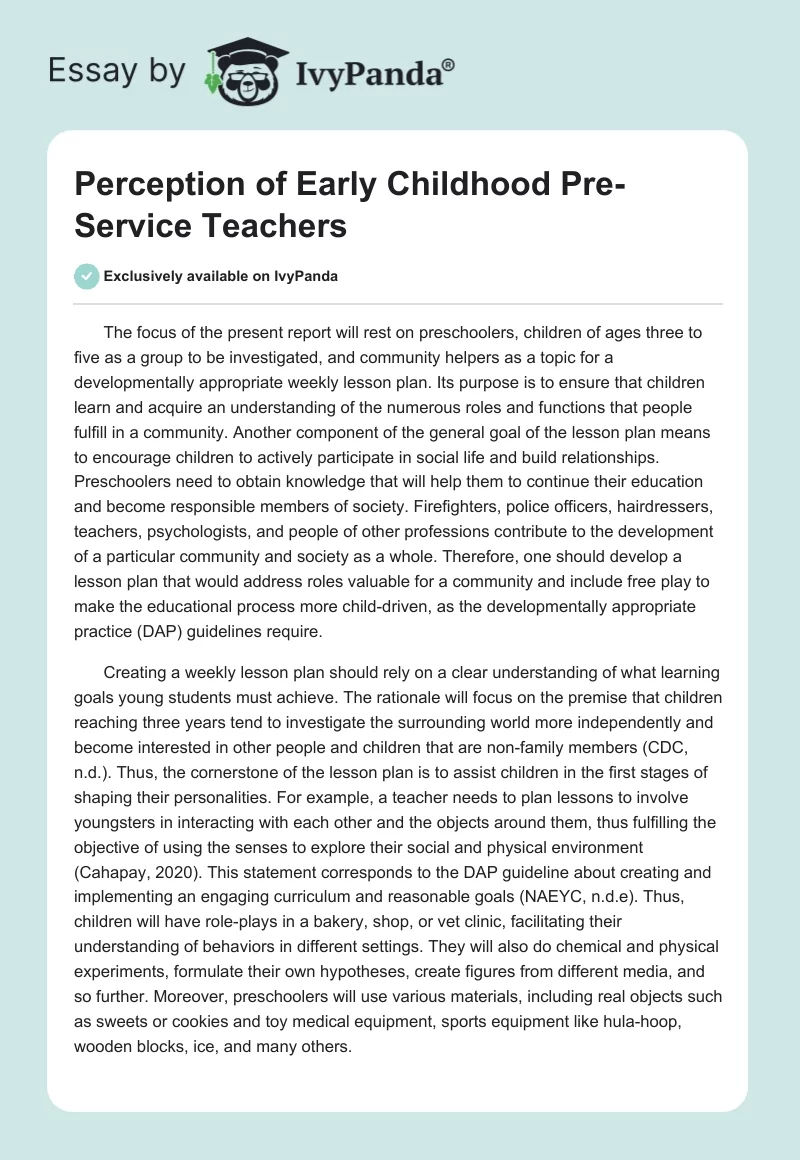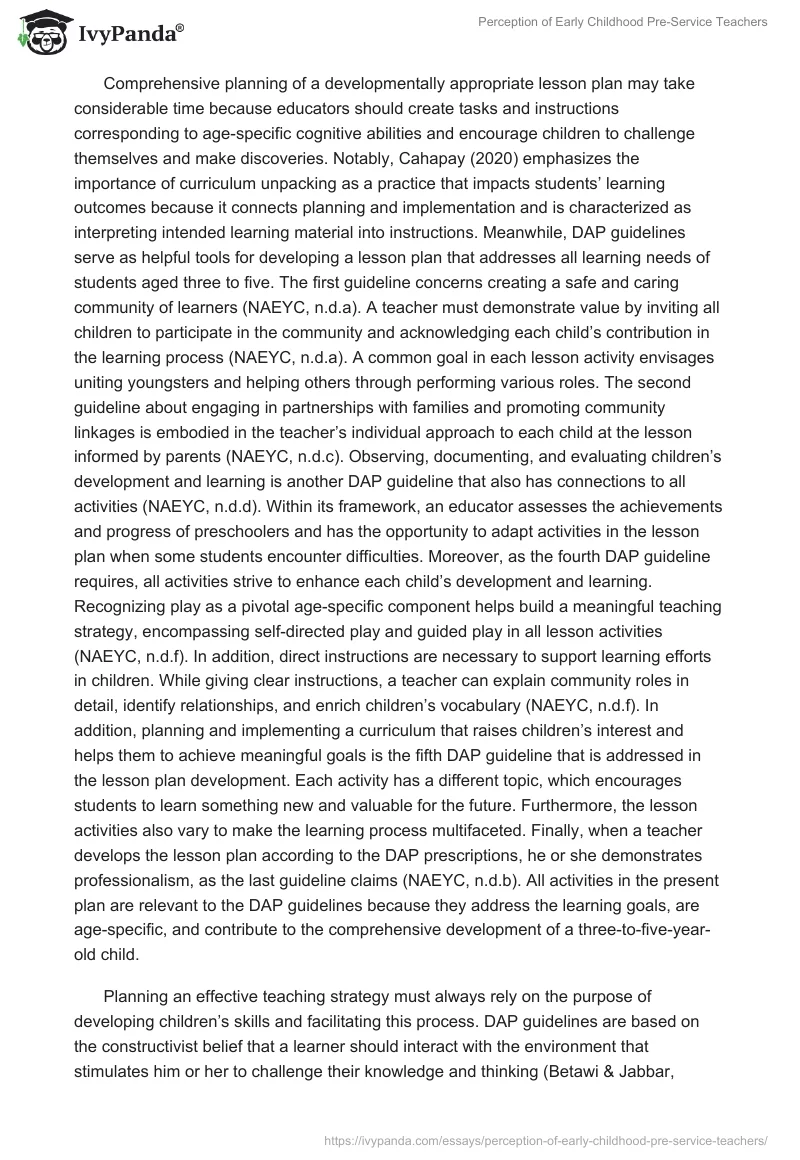The focus of the present report will rest on preschoolers, children of ages three to five as a group to be investigated, and community helpers as a topic for a developmentally appropriate weekly lesson plan. Its purpose is to ensure that children learn and acquire an understanding of the numerous roles and functions that people fulfill in a community. Another component of the general goal of the lesson plan means to encourage children to actively participate in social life and build relationships. Preschoolers need to obtain knowledge that will help them to continue their education and become responsible members of society. Firefighters, police officers, hairdressers, teachers, psychologists, and people of other professions contribute to the development of a particular community and society as a whole. Therefore, one should develop a lesson plan that would address roles valuable for a community and include free play to make the educational process more child-driven, as the developmentally appropriate practice (DAP) guidelines require.
Creating a weekly lesson plan should rely on a clear understanding of what learning goals young students must achieve. The rationale will focus on the premise that children reaching three years tend to investigate the surrounding world more independently and become interested in other people and children that are non-family members (CDC, n.d.). Thus, the cornerstone of the lesson plan is to assist children in the first stages of shaping their personalities. For example, a teacher needs to plan lessons to involve youngsters in interacting with each other and the objects around them, thus fulfilling the objective of using the senses to explore their social and physical environment (Cahapay, 2020). This statement corresponds to the DAP guideline about creating and implementing an engaging curriculum and reasonable goals (NAEYC, n.d.e). Thus, children will have role-plays in a bakery, shop, or vet clinic, facilitating their understanding of behaviors in different settings. They will also do chemical and physical experiments, formulate their own hypotheses, create figures from different media, and so further. Moreover, preschoolers will use various materials, including real objects such as sweets or cookies and toy medical equipment, sports equipment like hula-hoop, wooden blocks, ice, and many others.
Comprehensive planning of a developmentally appropriate lesson plan may take considerable time because educators should create tasks and instructions corresponding to age-specific cognitive abilities and encourage children to challenge themselves and make discoveries. Notably, Cahapay (2020) emphasizes the importance of curriculum unpacking as a practice that impacts students’ learning outcomes because it connects planning and implementation and is characterized as interpreting intended learning material into instructions. Meanwhile, DAP guidelines serve as helpful tools for developing a lesson plan that addresses all learning needs of students aged three to five. The first guideline concerns creating a safe and caring community of learners (NAEYC, n.d.a). A teacher must demonstrate value by inviting all children to participate in the community and acknowledging each child’s contribution in the learning process (NAEYC, n.d.a). A common goal in each lesson activity envisages uniting youngsters and helping others through performing various roles. The second guideline about engaging in partnerships with families and promoting community linkages is embodied in the teacher’s individual approach to each child at the lesson informed by parents (NAEYC, n.d.c). Observing, documenting, and evaluating children’s development and learning is another DAP guideline that also has connections to all activities (NAEYC, n.d.d). Within its framework, an educator assesses the achievements and progress of preschoolers and has the opportunity to adapt activities in the lesson plan when some students encounter difficulties. Moreover, as the fourth DAP guideline requires, all activities strive to enhance each child’s development and learning. Recognizing play as a pivotal age-specific component helps build a meaningful teaching strategy, encompassing self-directed play and guided play in all lesson activities (NAEYC, n.d.f). In addition, direct instructions are necessary to support learning efforts in children. While giving clear instructions, a teacher can explain community roles in detail, identify relationships, and enrich children’s vocabulary (NAEYC, n.d.f). In addition, planning and implementing a curriculum that raises children’s interest and helps them to achieve meaningful goals is the fifth DAP guideline that is addressed in the lesson plan development. Each activity has a different topic, which encourages students to learn something new and valuable for the future. Furthermore, the lesson activities also vary to make the learning process multifaceted. Finally, when a teacher develops the lesson plan according to the DAP prescriptions, he or she demonstrates professionalism, as the last guideline claims (NAEYC, n.d.b). All activities in the present plan are relevant to the DAP guidelines because they address the learning goals, are age-specific, and contribute to the comprehensive development of a three-to-five-year-old child.
Planning an effective teaching strategy must always rely on the purpose of developing children’s skills and facilitating this process. DAP guidelines are based on the constructivist belief that a learner should interact with the environment that stimulates him or her to challenge their knowledge and thinking (Betawi & Jabbar, 2019). In this regard, offering worksheets and coloring pages to youngsters are considered developmentally inappropriate practices (DIP) because they impede creativity (Creative Nest Nursery, 2020). Worksheets do not work as intended because they ignite no interest in children and do not suppose creating something from scratch. Furthermore, they provide no opportunity for free play and physical activity that are vital for a child’s proper and multisided development. Although worksheets may contain tasks related to imagination, a three-to-five-year-old is at the early phase of developing creativity and needs to know that it is not limited by a piece of paper and pencil. This assumption is equally fair concerning coloring pages, regardless of parents’ beliefs that it can develop fine motor skills (Creative Nest Nursery, 2020). However, coloring the picture drawn by an adult does not involve the process of thinking and imagination (Creative Nest Nursery, 2020). For example, the task of coloring a favorite cartoon figure requires keeping inside the lines and excludes any changes of color. Moreover, such activity may contribute to self-distrust and perfectionism, and a child will often need his abilities and achievements to be recognized. Preschoolers can learn the combination of the mentioned skills and creativity when drawing their own pictures or experimenting with colors and various media.
Any learning activity for preschoolers should include free play because it unlocks a child’s potential. Given this, a teacher should give particular freedom to youngsters to see what tasks are most interesting to them. Furthermore, young learners tend to explore the world and how it works, which can suggest an educator some new ideas for diversifying activities. DAP guidelines warn against one-sided approaches in teaching, such as parent involvement, that can also be applied to teachers (NAEYC, n.d.b). Teacher-directed activities demand children to complete tasks according to a specific sample, which simplifies the process of observing and assessment of skills. Although such activities are possible to teach youngsters basic skills in literacy, mathematics, or science, they may not be ready to perform some steps of a task independently. For instance, cutting some objects with scissors or mixing the right proportions of safe chemical substances like baking soda and vinegar can appear to be complicated. On the other hand, child-driven activities should be controlled because most preschoolers are restless and need frequent changes of tasks. With respect to the stated above, one cannot exclude a teacher-directed approach from the learning process. It is a question of reasonable combining and balancing between children’s freedom of expression and a teacher’s intervention.
Finally, completing the present project has given valuable insights regarding teaching. It has provided a deeper understanding of a preschooler’s development. Children of three-to-five-year age can be considered as young people in the early stages of forming a personality with a unique voice and expression. During this period, they acquire basic skills and independence, as well as the knowledge that sets a foundation for primary and secondary education. A clear understanding of children’s needs at this age can serve as an indispensable tool in developing lesson plans and teaching processes in the future. Keeping in mind that youngsters need to interact with the surrounding environment, an educator will put effort into scheduling a lesson in a park or forest to let children explore wildlife. Furthermore, preschoolers are spontaneous and expressive, so it makes sense to offer a task in which all children use the same media but create something independently. In addition, a future teacher must practice holding ‘controlling’ impulses when some children do a task in an unexpected way. Three-to-five-year-olds are delicate and sensitive, so they may become frustrated if something ‘must be done so and so’ without any option of adding new ideas. It also connects to a teacher’s behavior and the creation of a safe and inclusive environment where they do not fear asserting themselves. Thus, it is worth showing interest and value for each young learner by calling his or her name according to specific preferences, acknowledging their involvement during a lesson, and recognizing a child’s skills, experiences, and achievements.
References
Betawi, A., & Jabbar, S. (2019). Developmentally appropriate or developmentally inappropriate, that’s the question: Perception of early childhood pre-service teachers at the University of Jordan. International Journal of Adolescence and Youth, 24(1), pp. 40-50. Web.
Cahapay, M. B. (2020). A case study of curriculum unpacking practices of a kindergarten teacher. Journal of Curriculum and Teaching, 9(2), pp. 1-8. Web.
Centers for Disease Control and Prevention. (n.d.). Preschoolers (3-5 years of age). Centers for Disease Control and Prevention. Web.
Creative Nest Nursery. (2020). Why we avoid using coloring books!Creative Nest Nursery. Web.
National Association for the Education of Young Children. (n.d.a) DAP: Creating a caring, equitable community of learners. NAEYC. Web.
National Association for the Education of Young Children. (n.d.b) DAP: Demonstrating professionalism as an early childhood educator. NAEYC. Web.
National Association for the Education of Young Children. (n.d.c) DAP: Engaging in reciprocal partnerships with families and fostering community connections. NAEYC. Web.
National Association for the Education of Young Children. (n.d.d) DAP: Observing, documenting and assessing children’s development and learning. NAEYC. Web.
National Association for the Education of Young Children. (n.d.e) DAP: Planning and implementing an engaging curriculum to achieve meaningful goals. NAEYC. Web.
National Association for the Education of Young Children. (n.d.f) DAP: Teaching to enhance each child’s development and learning. NAEYC. Web.


